
|
Practical Lessons in
|
||||||||||||||||||||||||||||||||||||||||||||||||||||||||||||||||||||||||||||||||||||||||||||||||||||||||||||||||||||||||||||||||||||||||||||||||||||||||||||||||||||||||||||||||||||||||||||||||||||||||||||||||||||||||||||||||||||||||||||||||||||||||||||||||||||||||||||||||||||||||||||||||||||||||||||||||||||||||||||||||||||||
|
For There To Be True Adidam, There Must Be A Culture Of Devotional (or "Radical") Recognition Of Me, The Devotion To Me That Is Always "At The Root" — Not By Working On "self", Not By Turning attention "Within" (Through Dissociative Introversion), but Simply Through Whole bodily Recognition-Response To Me. If There Is A Culture That "Objectifies" Me and Reinforces The ego-Position In people, Addresses them As egos and consumers, Then You Never Have Adidam — Never. Therefore, The Gathering Of My Devotees Must Manifest The Culture Of True "Radical" Devotion To Me. The Culture Of Devotion To Me Is An Invocation-Culture, A Recognition-Responsive Culture, A Global Culture Of Adidam, In Which My Devotees (who Devotionally Recognize Me) Extend The Gift Of My Person and My Self-Revelation Everywhere, and With Full Effectiveness — Because They Are Full Of Me. Avatar Adi Da Samraj, Recognition Of Me Is Liberation |
|
The worship of the "Bright" must be established in this conditional realm. I Am the inherently egoless Divine (and Acausal) Person and the Avatarically-Born Divine (and Acausal) Self-Revelation of the "Bright". I must (in and as My Avatarically-Born bodily human Divine Form and Person) be whole bodily (or in a total psycho-physical, and, ultimately, most perfectly egoless, manner) heart-recognized as the "Bright". Only one who thus (ever more deeply) heart-recognizes Me is My true (and, ultimately, truly perfect) devotee. . . I am not merely in the Divine State. I Am the Divine State — here and forever now. My inherent Divine State and inherently egoless Divine Personal Identity is (now, and forever hereafter) spontaneously Self-Transmitting itself — as Me (Avatarically Self-Manifested in and as My Avatarically-Born bodily human Divine Form, and Avatarically Self-Transmitted as and by means of My always-Blessing Divine Spiritual Presence, and, altogether, Avatarically Self-Revealed as My Divine, and very, and inherently egoless State). Avatar Adi Da Samraj, Chapter 17, The Scapegoat Book |
Primary cultural resources on devotional recognition of Adi Da
include the books, Recognition
Of Me Is Liberation and Right
Life Is Free Participation In Unlimited Radiance (particularly
"Part Two: Right-Life Practice Is An Unfolding of Devotional
Recognition-Response To Me"). Another useful resource is
our article, The Significance
of Recognition in the Way of Adidam.
|
|
|
|||||||
|
||||||||
|
|
|
|||||||
Positive disillusionment. A secondary dimension of the core practice is positive disillusionment. It is one of the key prerequisites for actually advancing in the practice of the Way of Adidam.
|
Before the foundation phase (or first phase) of the ego-transcending Great Process of the only-by-Me Revealed and Given Reality-Way of Adidam can (itself) be complete, it must Realize a profoundly life-transforming and life-reorienting “positive disillusionment”, or a most fundamental (and really and truly “self”-contraction-transcending) acceptance of the fact that gross conditional existence is inherently and necessarily unsatisfactory and unperfectable (and, therefore, a most fundamental — and really and truly Me-Finding and search-ending — acceptance of the fact that all seeking to achieve permanent and complete gross satisfaction of separate body, emotion, and mind is inherently and necessarily futile). Only on the basis of that necessary foundation-Realization of “positive disillusionment” can the functional life-energy and the attention of the entire body-mind-complex (or of the total body-brain-mind) be released from gross ego-bondage (or “self”-deluded confinement to the psycho-physical illusions of gross “self”-contraction). Avatar Adi Da Samraj, Chapter 17, The Gnosticon |
Because all of us have engaged in illusions about the nature of happiness for lifetimes, it can take us quite a few years (or even lifetimes) to go through the "positive disillusionment" process. While conventionally, the word, "disillusionment", has a mixed connotation (e.g., "older but wiser"), Adi Da refers to the process associated with Him as "positive" because the disillusionment frees up one's life and destiny for a Greater Alternative.
A primary cultural resource on positive disillusionment is Adi Da's essay, "Perfect Dis-Illusionment", in Part 8 of The Aletheon. You can also watch this video.
Until one has successfully completed the "positive disillusionment" consideration, one tends to be "double-minded": having one foot in the "self-fulfillment" camp, and one foot in the "self-transcendence" camp, with the bigger foot in self-fulfillment, compromising one's practice of the Way of Adidam. With positive disillusionment, the "self-fulfillment" alternative collapses, double-mindedness disappears, and both one's feet are now solidly in the "self-transcendence" camp.
|
You cannot be trying to fulfill the ego and your egoic conventional patterning, and transcend it at the same time. You must relinquish it utterly, altogether. The two do not come together. It is a sadhana, and that is that. Avatar Adi Da Samraj, February 19, 2001 |
There are many dimensions to the "positive disillusionment"
consideration, including:
-
really getting that "it doesn't work out here", including really feeling and accepting the reality of one's mortality. (Roger Briggs' leela below is an excellent example of this point.)
- really getting that one cannot find Eternal, unconditional love in human friends and family, only in the Divine Person. (Adi Da's talk, Identification of the Beloved, is an excellent resource for this point.)
- really getting the lesson of life: that you cannot become happy, you can only be (already) Happy. All efforts to arrange circumstances in such a way that you "become happy" are at best temporary and limited, with one's own mortality being the ultimate limit that makes all arrangements temporary.
- really getting that the process of self-transcendence (essential to God-Realization) is going to involve a lot of tapas (heat), and is not going to be turned into just a "bliss ride" or "the Way of Fun" because of Adi Da's Transmission.
|
|
|
|||||||
|
||||||||
|
|
|
|||||||
2. Lessons About Egoic Patterning
The entire Way of Adidam is about ego-transcendence: transcendence of egoic patterning. However, Adi Da has singled out certain certain key forms of egoic patterning worthy of special attention. These include: oedipal patterning; character type (solid, peculiar, vital); and self-pity, negativity, and self-imagery.
Oedipal / emotional-sexual patterning. Early in the twentieth century, Freud observed that emotional-sexual conflicts originate in the “oedipal” dynamic between children and their parents. He saw that one's sexual impulses, which are present even in early childhood (especially in relation to one's parents), are at the root of various emotional patterns and psychological problems. There can be no basic emotional ease or equanimity in human life until individuals achieve at least a personal resolution to this conflict, and mastery of their oedipal patterning. Adi Da has observed that such self-understanding is an essential part of the foundation of human maturation upon which genuine spiritual growth must be based:
|
Freud wanted to bring his own emotional-sexual tendencies under the control of the social ego. Thus Freud suppressed himself — because he saw that the un-mastered emotional-sexual ego is wild and powerful. That suppressive disposition (or "point of view") is not a workable basis for Spiritual life. Avatar Adi Da Samraj I Call My devotees to the transcending of any obstruction of energy, any dramatization of the “self”-contraction in relation to sex or any other aspect of life. I do not have a moralistic reaction to anything about the emotional-sexual life of human beings. To Me, emotional-sexual difficulty (of whatever kind) is simply a sign of egoity in whomever it appears — and, therefore, it is simply something that the individual must deal with in a straightforward, non-problematic, non-puritanical, and, altogether, non-paranoid (or fearless) manner. (Ibid, pp. 25-26) Avatar Adi Da Samraj, Chapter 17, The Gnosticon I Am the One Who has made it possible for human beings to totally comprehend the emotional-sexual dimension of existence, and to completely transcend egoic reactivity, and to truly grow beyond the ordinary emotional-sexual limitations that the "worldly" mind represents, and (by all of this) to have an altogether — and in Reality — sane life. Avatar Adi Da Samraj, Always Enact Fidelity To Me |
Adi Da also pointed out that the Guru-devotee relationship itself tends to be impacted by the devotee's oedipal patterning. Women devotees tended to approach Adi Da (and, indeed, all men) as "daddy" or "lover", often rejecting and betraying others, including their intimates, for access to Him. Meanwhile, men tended to approach Adi Da (and all male "others") — not only as "daddy", but as "rival" and "opponent" — competing (in the case of Adi Da) for victory over Him in all the games of life. So understanding and transcending one's oedipal patterning is essential to growth in the relationship with Adi Da Samraj, and the Spiritual Realization associated with that growth.
Primary cultural resources on oedipal patterning are the books, Always Enact Fidelity To Me and The Complete Yoga of Human Emotional-Sexual Life.
|
|
|
|||||||
|
||||||||
|
||||||||
|
||||||||
|
|
|
|||||||
Character
type: solid, peculiar, vital. Avatar Adi Da has observed
that everyone is crippled in the dimension of feeling. And He
went on to point out that there are three characteristic ways
whereby human beings strategically fail to feel (or actively avoid
relationship) by resorting instead to the exaggerations of either
the gross physical, the emotional, or the mental possibilities
that the body-mind affords. Adi Da Samraj calls these strategies,
respectively, "vital", "peculiar", and "solid".
Studying these character strategies and discovering ourselves
in them is a key part of the process of self-understanding as
well as a compassionate understanding of others in the Way of
Adidam.
The vital person is obsessed with submission to the energy, or vital force, of bodily life. The vital person exploits or yields to the physically oriented power and desires of the vital being, the navel. When his or her “moon” is full, the vital person may be hyperactive, gleeful, negative, violent, self-conscious, obsessed, and self -indulgent relative to food, sex, and casual speech. He or she communicates these qualities with force, from the navel. There is no true humor in the vital person—only irony or hysteria or vulgar enthusiasm. The vital person becomes completely absorbed in the aspect of his or her vital life that happens to be presently in phase. As his or her moon phases, the vital person may even take on apparent qualities of solidity and peculiarity, but they are only a play in him or her that further demonstrates the underlying power of his or her fixed vital strategy.
The peculiar person is one whose principal focus of attention and dramatization is the emotional-sexual being. Such a one tends to physical weakness, alienation from gross functions and requirements of life, and sympathy with egoic satisfactions in emotional and even psychic forms. The peculiar person may reflect the apparently “higher” and aesthetic range of emotional life, and he or she may exhibit interests and tendencies in myst ical and Yogic developments of experience. The peculiar person is, thus, in his or her negative reaction to the gros s physical, tending to project himself or herself into the more ascended or ascending ranges of experience, which move toward or are epitomized in psychic and psychological dimensions of a subtle, subconscious, or dreamlike variety.
The solid person is one in whom the verbal-mental, or willful and conceptual, functions are the focus of life and attention. Thus, the solid person stands on or chronically controls the emotional, sexual, energetic, and gross physical dimensions of his or her being with complex mental structures that rigidify his or her psyche. Such a one chronically assumes the position of the verbal mind in the midst of the descending and ascending pattern of life. He or she is usually willful, and through force subdues and controls the pervasive influence of emotion, sex, and physical experience. The solid person phases from absolute rigidity (unreceptive and uncreative) to varying degrees of emotional and physical sympathy. He or she feels excessively vulnerable to emotions and threatened by all demands on his or her feeling and psychic being, including pain, pleasure, and mortality, a nd so the solid person generally tends toward a rigid, verbal-mental, and self-conscious pattern of self-presentation. The solid person’s principal reaction is to the energetic, psychic, and emotional-sexual dimension of his or her being. The solid person tends to be constitutionally stronger in the physical than the peculiar person, but he or she also tends to be neglectful of the physical.
The three character types are not mutually exclusive. A given person's character type might be best explained by one, two, or all three of these strategies.
Primary cultural resources on character type are the book, The Eating Gorilla Comes in Peace (particularly Chapter 5: The Imbalancing Act) and The Dawn Horse Testament.
|
|
|
|||||||
|
||||||||
|
|
|
|||||||
Rudi's
trifecta: self-pity, negativity, and self-imagery. When
Adi Da was a student of Swami Rudrananda ("Rudi"), He said Rudi
used to repeatedly stress the profoundly negative impact of self-pity
on spiritual practice:
|
So the religious life involves sadhana, practice, purification, transcendence, ultimately self-transcendence, ego-transcendence, or transcendence of the separate self-presumption. But also the transcendence of negativity. Rudi used to say, on occasion, there are three things to deal with: self-imagery, negativity, and self-pity. And they're all really variations on the same thing, you see? I talk to you in terms of such dispositions. . . It requires profound practice to overcome these adaptations — not only identification with the body-mind itself, but everything that comes about as a result of that: all this negativity, this suffering, and pain, psychological pain, emotional disturbance, and so forth. These are all signs of contraction, self-contraction, the effect of it being that the inherent Nature of Reality, Which is Radiant Love-Bliss, Self-Existing, Self-Radiant, is apparently an experience lost. You feel Lightless, un-Enlightened, tending toward un-Consciousness, and identified with all kinds of limitations that you don't enjoy. Sometimes you enjoy them. Most of the time experience is mixed, with a lot of negative associations one way or another. Avatar Adi Da Samraj, "The Condition of Radiance" |
|
|
|
|||||||
|
||||||||
|
|
|
|||||||
3. Lessons About the Functional, Practical,
and Relational Disciplines
These disciplines include: diet; health and radical healing; conscious exercise; sexuality; money and service; and cooperative community.
The primary cultural resource on the functional, practical, and relational disciplines is the book, Right Life Is Free Participation In Unlimited Radiance (particularly "Part Five: The Functional, Practical, Relational, and Cultural Disciplines of The Reality-Way of Adidam").
Diet.
Diet is of fundamental importance to practice of the Way of Adidam.
Our diet has a profound effect on our overall health, level of
energy, general state of well-being, and free attention. Avatar
Adi Da has frequently remarked that a good deal of what is troubling
individuals — including in the emotional dimension — could be
corrected simply by a change in eating habits. Previous to His
Divine Re-Awakening, Avatar Adi Da Himself experimented with diet
and read many books on the subject, with the intention of discovering
the most supportive dietary regime for spiritual practice. During
the years of His Teaching Work, He developed this Consideration
to its conclusion.
|
Among all the functional, practical, relational, and cultural disciplines that serve the practice of the only-by-Me Revealed and Given Reality-Way of Adidam, the conservative discipline (or control) of diet is (elementally) the most basic — because dietary practice (which controls, or largely determines, the state of the food-body, or the state and general activity of the physical body) also determines the relative controllability of social, sexual, emotional, mental, and all other functional desires and activities. The right and optimum diet is (necessarily) a conservative diet. In right (or effective) practice of the Reality-Way of Adidam, dietary discipline fully serves the submission of personal energy and attention to the Great Process that becomes (Ultimately, by Means of My Divine Avataric Transcendental Spiritual Grace) Most Perfect Divine Self-Realization. Adidam, the right and optimum diet must be intelligently moderated in its quantity and carefully selected in its quality, so that it will not burden the physical body or bind the mind (or attention) through food-desire and negative (or constipating, toxifying, and enervating) food-effects (and ingestion-effects in general), and so that (along with the necessary additional "consideration" and really effective transcending of addicted, aberrated, anxious, or even excessively private habits and patterns relative to food-taking and waste-elimination) it serves the yielding (or freeing) of functional human energy and attention to the great (and, necessarily, devotionally Me-recognizing and devotionally to-Me-responding) process of the intrinsic and fully life-effective transcending of the ego-"I". Avatar Adi Da Samraj |
The primary cultural resources for diet in the Way of Adidam
are Green
Gorilla and Right
Life Is Free Participation In Unlimited Radiance (particularly
the section of "Part Five: The Functional, Practical, Relational,
and Cultural Disciplines of The Reality-Way of Adidam" on
diet).
|
|
|
|||||||
|
||||||||
|
|
|
|||||||
4. Lessons About the Cultural
Practices
|
Only a sacred culture gives human beings the potential to live a life ecstatically dedicated to existence in Truth. . . . [The cultural practices of Adidam] are the means that enable [Adi Da's] devotees to find Him as the Divine Eternal Source of Reality Itself and to participate in the Sacred Space of That Reality. Ruchiradama Quandra Sukhapur Rani Naitauba |
The cultural practices in the Way of Adidam include: Darshan; meditation; Name invocation; puja; devotional chanting; the Sacrament of Universal Sacrifice; studying and listening to Adi Da's Word; Beholding Adi Da's Image-Art; telling leelas about Adi Da; visiting and making right use of the Adidam Empowered Sanctuaries, Holy Sites, and Communion Halls; the Devotional Prayer of Changes; the culture of inspiration and expectation; and practice consideration groups.
A primary cultural resource on cultural practices in Adidam is the book, The Sacred Space Of Finding Me.
Devotional
chanting. The practice of devotional chanting to Avatar
Adi Da is a powerful means for serving the connection with Him
and the magnification of devotion to Him. Like all the other forms
of whole bodily engaged devotional activity, chanting serves the
purpose of turning all the faculties of the body-mind (attention,
feeling, body, and breath) to Adi Da Samraj, in a single heart-based
gesture of devotional response.
|
|
|
|||||||
|
||||||||
|
|
|
|||||||
Visiting and making right use of the Adidam Empowered Sanctuaries, Holy Sites, and Communion Halls. Traditionally, Spiritual Masters have been provided with places that were set apart — geographically, psychically, and socially — from the conventional world, places where they were free to do their Spiritual Work in an appropriate and secluded circumstance. These places became Spiritually Empowered through their Presence and Work, and — as a result — continued to Spiritually Transmit the Blessing of the Spiritual Master beyond His or Her human lifetime. Avatar Adi Da has established and spiritually empowered five Sanctuaries for all time. There is nothing like visiting the holy places He established (short of having come into Adi Da's physical company during His lifetime) — because He installed Himself there Spiritually for all time, and His Presence pervades the physical space, because of His Eternal connection to it.
|
|
|
|||||||
|
||||||||
|
||||||||
|
|
|
|||||||
The
Devotional Prayer of Changes. The Devotional Prayer of
Changes is a practice given by Adi Da Samraj of prayerful Communion
with Him for the sake of positive change in life-circumstances
and the world.
|
Your responsibility does not depend on your "creature"-power or ego-power. It depends on your participation in Me, and on your engaging in the practices that establish your own mechanism as the means for the very same things you are presently calling on Me to Do by what may look to you to be My Personal Intention. This is another characteristic of My Sign and My Demonstration of My Divine Indifference. I have Shown you how to do everything. Now your Devotional Prayer of Changes becomes effective because you use My Virtue, through your practice of whole bodily devotional turning to Me, and through your taking your responsibilities seriously rather than imagining that they are only mysterious obligations that have nothing to do with you. You are drawing on My Virtue simply by practicing the Devotional Prayer of Changes, or true whole bodily devotional turning to Me. You allow your own mechanism to become the means. My devotees are to provide the body-minds whereby My Virtue becomes Effective. If you will really do so, then changes will occur. Yes, they will be changes that I have Made, but in the fashion I have just Described to you. So it will be forever. That My devotees have received the Secret of whole bodily devotional turning to Me allows My Divine Translation. It allows Me to be Effective forever throughout the cosmic domain. My Virtue Changes things and Enlightens beings, and It Works, because My devotees assume their responsibilities by embracing the practices I have Given them, doing those practices for real, and using My Virtue. When the time comes that This Body dies, I will not disappear. I will be wholly Available to you. I will be Effective forever — Fully Conscious, Self-Radiant, never gone, never separate. In devotional Communion with Me, you associate with, participate in, and draw upon My Own Virtue. That is the Secret of devotional Communion with Me. It has always been the case, but you did not know the Secret. I have Come to Reveal That Secret and to Establish the Fullest Instruction. By your devotional recognition-response to Me, you give Me the Mechanism to Do the same kind of Work I have been Doing in My bodily (human) Lifetime here. I will be Incarnated countlessly by Means of this Process. Avatar Adi Da Samraj |
Adi Da contrasts the Devotional Prayer of Changes — which is based
on present-time Communion with the Divine (and the Virtue that
flows from that) with conventional prayer — which is based on
separation from the Divine and the presumption that the Divine
is a Great Other whom one can approach like a parent for favors
and blessings.
The stories below are about a particular form of the Devotional
Prayer of Changes: the Adidam Prosperity Puja. "Puja"
means sacramental worship and invocation of the Divine in a bodily
active manner (in contrast with, say, meditation). In an Adidam
Prosperity Puja, participating devotees engage in a powerful,
collective form of the
Devotional Prayer of Changes and sacramental worship of
Adi Da. It is a time when the participants invoke Adi Da's Divine,
All-Accomplishing Power and specifically visualize abundance and
growth and relinquish all presumed limitations to prosperity.
|
|
|
|||||||
|
||||||||
|
||||||||
|
||||||||
|
||||||||
|
||||||||
|
|
|
|||||||
Practice
consideration groups. (Aka devotional groups.) Practitioners
of the Way of Adidam are aided in their practice by belonging
to a practice consideration group. A practice consideration group
is a key element of the culture of Adidam. Its primary purposes
are to provide occasions for collective devotional invocation
of Adi Da, and to help each other grow in ego-transcending practice.
Through time and intimacy, members of a practice consideration
group get to know each other well, and therefore, get to know
each other's egoic patterning as well. Group members are thus
in a unique position to serve each other's practice, by seeing
things a particular member might not see about himself or herself,
by helping members take on disciplines that cut into their particular
egoic patterns, and by helping members stay accountable for fulfilling
and persisting in the counter-egoic disciplines they take on.
Such reflection and disciplining of egoic patterning is essential
for growth in practice of the ego-transcending Way of Adidam.
A primary cultural resource on practice consideration groups is Adi Da's talk, "When the Tiger Disappears".
|
|
|
|||||
|
||||||
|
|
|
|||||
 Birth, Life & Death
Birth, Life & Death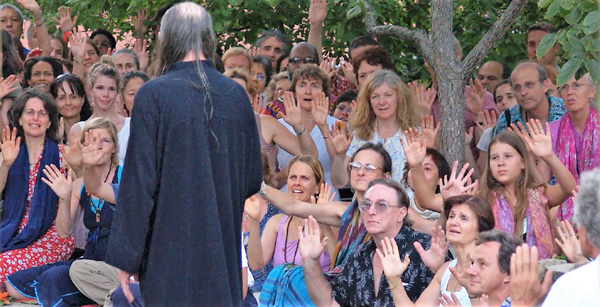

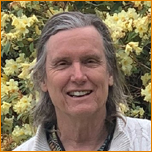





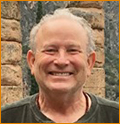
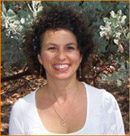


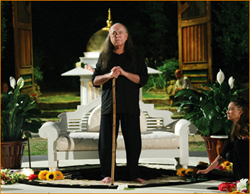
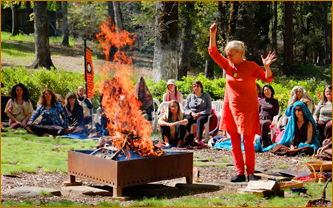
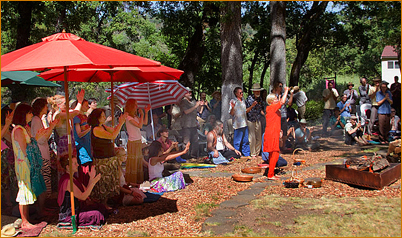

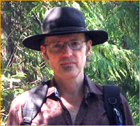
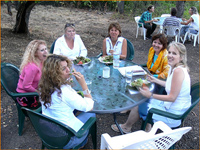
186,104 people have liked our site's pages and shared them with their Facebook friends - Most Shared Pages
© 2025 Copyrighted materials used with the permission of The Avataric Samrajya of Adidam Pty Ltd, as trustee for The Avataric Samrajya of Adidam. All rights reserved. None of these materials may be disseminated or otherwise used for any non-personal purpose without the prior agreement of the copyright owner. ADIDAM is a trademark of The Avataric Samrajya of Adidam Pty Ltd, as Trustee for the Avataric Samrajya of Adidam.
Technical problems with our site? Let our webmaster know.